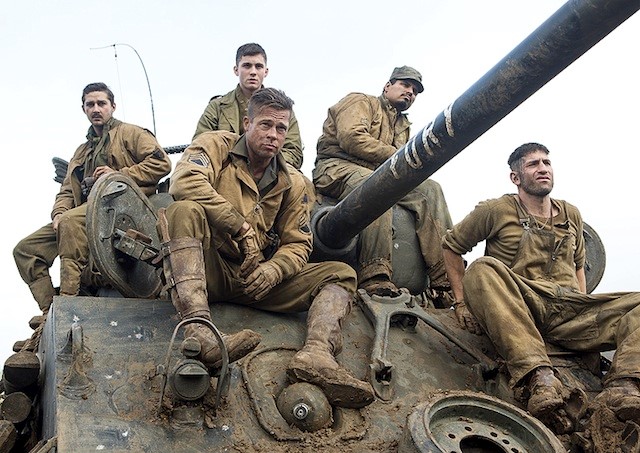Fury (2014)
CAST: Brad Pitt, Logan Lerman, Shia LaBeouf, Jon Bernthal, Michael Pena
REVIEW:
One of the most intense, gritty, and brutal WWII films since Saving Private Ryan (possibly even surpassing it for graphic bloodshed), and one of the best war films to come along in years, Fury dispels the notion that the Allies’ post D-Day race toward Berlin (a race they lost to the Russians) was any kind of cakewalk. Leave it to the likes of Patton to show montages of Allied columns roaring triumphantly down roadways as rousing music plays; Fury takes us down to the ground, spending much of the action inside one tank with one small crew slogging their way through Germany. Of course, that is no criticism of Patton, just that the two films show the war from complete opposite perspectives. Those who enjoyed (if “enjoyed” is an appropriate word) Saving Private Ryan should appreciate Fury. In fact, Fury goes even further than Steven Spielberg’s epic in being completely devoid of any flag-waving patriotism or idealism. This is a war movie that lives up to the saying “war is hell”. Continue reading
Lawless (2012)
DIRECTOR: John Hillcoat
CAST: Shia LaBeouf, Tom Hardy, Jessica Chastain, Guy Pearce, Mia Wasikowska, Gary Oldman, Jason Clarke, Dane DeHaan
REVIEW:
Based on Matt Bondurant’s 2008 historical novel The Wettest County in the World, a semi-fictionalized account of the Prohibition-era bootlegging activities of his grandfather Jack Bondurant and his grand-uncles Forrest and Howard, Lawless doesn’t reach the level of the bootlegging film classics it aspires toward, but it’s still an entertaining and engaging, if unspectacular, outlaw adventure that’s soaked in enough blood and moonshine to appeal to fans of the genre. Its release in late August, generally regarded as a dumping ground for films the studios are not confident enough about to release at the height of summer, is a bit of a shame. Lawless is a well-made movie that deserves a higher profile than it received. Continue reading
Eagle Eye (2008)
DIRECTOR: D.J. Caruso
CAST:
Shia LaBeouf, Michelle Monaghan, Billy Bob Thornton, Rosario Dawson, Michael Chiklis, Ethan Embry, William Sadler, Julianne Moore (voice)
REVIEW:
The kind of movie that epitomizes brainless entertainment, Eagle Eye (reteaming director D.J. Caruso and star Shia LaBeouf from last year’s superior Disturbia, and written by Roberto Orci and Alex Kurtzman, who penned the same year’s Transformers, which also starred LaBeouf and like this was produced by Steven Spielberg) can be a mindlessly entertaining ride as long as you check your brain at the door, but actually expecting anything onscreen to hold up to even perfunctory scrutiny is expecting too much from what’s on display. Continue reading
Indiana Jones and the Kingdom of the Crystal Skull (2008)
DIRECTOR: Steven Spielberg
CAST:
Harrison Ford, Shia LaBeouf, Cate Blanchett, Karen Allen, Ray Winstone, John Hurt, Jim Broadbent
REVIEW:
Indiana Jones and the Kingdom of the Crystal Skull, coming nineteen years after the so-called Last Crusade; nineteen years for fan expectations to climb to levels no film can satisfy. Series writer George Lucas has previously felt the wrath of disappointed fans with his Star Wars prequels sparking (over-the-top) accusations of ruined childhoods, and now he gets to experience it again. Part of it is surely that it’s simply been a very long time since Indiana Jones rode into action, and it is perhaps unfair to expect the new installment to recapture the old magic where it left off. But it’s hard to give Lucas and director Steven Spielberg too much slack, because even all things considered, Indiana Jones and the Kingdom of the Crystal Skull is as unwieldly as its overlong name, the most lifeless entry in the series, overplotted, unevenly paced, and meandering, and feels like a superfluous entry in a series that’s past its prime.
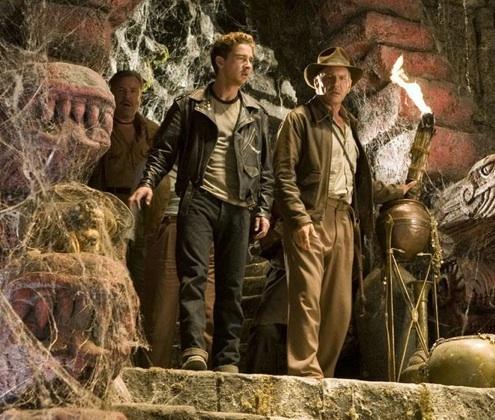 We start with the requisite Indy prologue in 1957 Nevada, where Soviet KGB agents led by Irina Spalko (Cate Blanchett, sporting a tight Soviet uniform, her hair in a black bob cut, an icy expression, and a Russian accent; she never tells Indy ‘ve have vays to make you talk’, but she always seems like she’s about to) have dragged a kidnapped Dr. Jones (Harrison Ford) and his latest sidekick, the unreliable Mac (Ray Winstone), to a secret US army warehouse (the same warehouse where the Ark of the Covenant was stashed away at the end of Raiders). There is something there Spalko wants, and she intends on forcing Indy to find it for her. The item in question turns out to be the legendary Crystal Skull, which she believes has paranormal powers. Apparently Spalko was Stalin’s foremost expert on paranormal studies and believes the skull can be a weapon to tip the scales of the Cold War in the Soviet Union’s favor. Of course this scene ends with a daring Indy escape, and one of the movie’s most clever bits. Indy, on the run from the pursuing Russians, blunders into a town in the middle of the desert, only to find that it’s eerily populated entirely by mannequins, and as the siren begins to wail, realizes to his horror that it is an artificial town built to study the effects of an atomic bomb blast. Making an unlikely but creative escape from seemingly certain doom with the help of what has to be the sturdiest refrigerator on the face of the Earth, Indy eventually manages to make it back to his teaching duties at Marshall College (the first shot of Indy’s university, which looks exactly the same, brings back nostalgic memories). But his troubles are a long way from over. In the climate of 1950s anti-Communist paranoia, Indy’s ‘collaboration’, however unwilling, with Soviet spies, has the FBI taking ‘great interest’ in him, and the sympathetic dean (Jim Broadbent, basically filling in a couple scenes that in the 1980s would have been played by the late Denholm Elliott) has been pressured to show him the door. Indy packs his bags, but no sooner has he boarded the train than he’s approached by a motorcycle-riding young punk called Mutt Williams (Shia LaBeouf), who looks and acts like a Marlon Brando/James Dean wannabe and has come for Indy’s help in finding his mother, who went missing in Peru while herself searching for Professor Oxley (John Hurt), an old colleague of Indy’s, who went mad while obsessively seeking the Crystal Skull. Indy isn’t sure exactly what any of this has to do with him, until he finds out the boy’s missing mother is none other than his old flame Marion Ravenwood (Karen Allen). With Mutt as his self-appointed latest sidekick, Indy sets off on a new adventure that will take him to the depths of the Peruvian jungle, and finds himself in a race against the Soviets led by Spalko to find the legendary Kingdom of the Crystal Skull.
We start with the requisite Indy prologue in 1957 Nevada, where Soviet KGB agents led by Irina Spalko (Cate Blanchett, sporting a tight Soviet uniform, her hair in a black bob cut, an icy expression, and a Russian accent; she never tells Indy ‘ve have vays to make you talk’, but she always seems like she’s about to) have dragged a kidnapped Dr. Jones (Harrison Ford) and his latest sidekick, the unreliable Mac (Ray Winstone), to a secret US army warehouse (the same warehouse where the Ark of the Covenant was stashed away at the end of Raiders). There is something there Spalko wants, and she intends on forcing Indy to find it for her. The item in question turns out to be the legendary Crystal Skull, which she believes has paranormal powers. Apparently Spalko was Stalin’s foremost expert on paranormal studies and believes the skull can be a weapon to tip the scales of the Cold War in the Soviet Union’s favor. Of course this scene ends with a daring Indy escape, and one of the movie’s most clever bits. Indy, on the run from the pursuing Russians, blunders into a town in the middle of the desert, only to find that it’s eerily populated entirely by mannequins, and as the siren begins to wail, realizes to his horror that it is an artificial town built to study the effects of an atomic bomb blast. Making an unlikely but creative escape from seemingly certain doom with the help of what has to be the sturdiest refrigerator on the face of the Earth, Indy eventually manages to make it back to his teaching duties at Marshall College (the first shot of Indy’s university, which looks exactly the same, brings back nostalgic memories). But his troubles are a long way from over. In the climate of 1950s anti-Communist paranoia, Indy’s ‘collaboration’, however unwilling, with Soviet spies, has the FBI taking ‘great interest’ in him, and the sympathetic dean (Jim Broadbent, basically filling in a couple scenes that in the 1980s would have been played by the late Denholm Elliott) has been pressured to show him the door. Indy packs his bags, but no sooner has he boarded the train than he’s approached by a motorcycle-riding young punk called Mutt Williams (Shia LaBeouf), who looks and acts like a Marlon Brando/James Dean wannabe and has come for Indy’s help in finding his mother, who went missing in Peru while herself searching for Professor Oxley (John Hurt), an old colleague of Indy’s, who went mad while obsessively seeking the Crystal Skull. Indy isn’t sure exactly what any of this has to do with him, until he finds out the boy’s missing mother is none other than his old flame Marion Ravenwood (Karen Allen). With Mutt as his self-appointed latest sidekick, Indy sets off on a new adventure that will take him to the depths of the Peruvian jungle, and finds himself in a race against the Soviets led by Spalko to find the legendary Kingdom of the Crystal Skull.
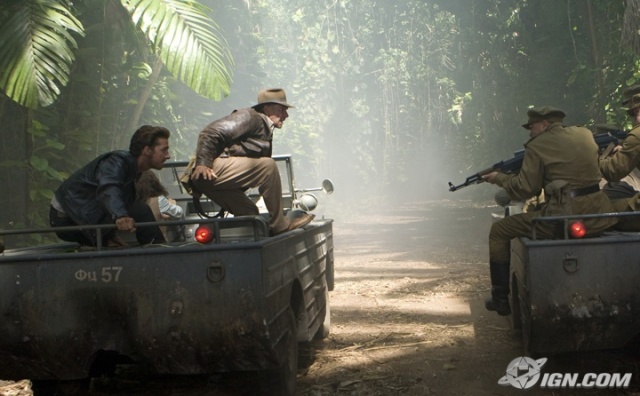 If the above sounds unnecessarily convoluted, that fits the tone of the movie, which has a tendency to get long-winded about things the others wisely kept simple. The Crystal Skull (or skulls, as it turns out) is given the most laborious backstory of any of the series’ MacGuffins, with both Indy and Spalko delivering swaths of exposition about it. The old movies had the right idea; a quick summary and move on. After all, the joy of any Indiana Jones film is not the destination, it’s the journey. The Crystal Skull, like the Ark of the Covenant, the Sankara stones, and the Holy Grail, is a plot device to move us from point A to point B and string the action sequences together. Also, while they’re an obvious choice for the bad guys given the Cold War 1950s setting, the Soviets are somewhat weaker villains than the Nazis. Even Steven Spielberg himself noted once that Nazis are so easy to use as villains because they are a virtually universal symbol of evil; the Soviets just don’t generate the same boo hiss effect. Spalko’s motives are a little murky; a bunch of vague rambling about psychic warfare, using the supposed vast combined mind-controlling power of the reunited skulls to take over the US without firing a shot (‘we will change you”, she says, “and the best part is, you won’t even know it’s happening’). The old movies kept the bad guys’ motives simple: power, world domination, eternal life. Spalko’s seem both underdeveloped and over explained.
If the above sounds unnecessarily convoluted, that fits the tone of the movie, which has a tendency to get long-winded about things the others wisely kept simple. The Crystal Skull (or skulls, as it turns out) is given the most laborious backstory of any of the series’ MacGuffins, with both Indy and Spalko delivering swaths of exposition about it. The old movies had the right idea; a quick summary and move on. After all, the joy of any Indiana Jones film is not the destination, it’s the journey. The Crystal Skull, like the Ark of the Covenant, the Sankara stones, and the Holy Grail, is a plot device to move us from point A to point B and string the action sequences together. Also, while they’re an obvious choice for the bad guys given the Cold War 1950s setting, the Soviets are somewhat weaker villains than the Nazis. Even Steven Spielberg himself noted once that Nazis are so easy to use as villains because they are a virtually universal symbol of evil; the Soviets just don’t generate the same boo hiss effect. Spalko’s motives are a little murky; a bunch of vague rambling about psychic warfare, using the supposed vast combined mind-controlling power of the reunited skulls to take over the US without firing a shot (‘we will change you”, she says, “and the best part is, you won’t even know it’s happening’). The old movies kept the bad guys’ motives simple: power, world domination, eternal life. Spalko’s seem both underdeveloped and over explained.
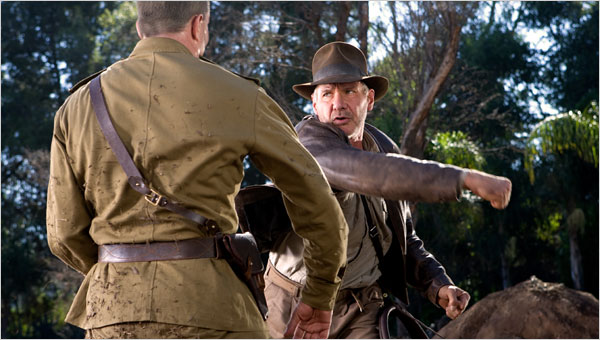 The problem isn’t the cast. Despite the nineteen years that have passed since he last donned the fedora, Harrison Ford slips back into Indiana Jones’ outfit and persona like an old, well-worn, comfortable shoe. Indiana Jones has always been the role Ford seems the most perfectly at home in, and he does an admirable job of slipping back into a character he last played in 1989. It’s telling of Ford’s enjoyment of the role that after a string of bored, autopilot performances in recent roles, he seems easily the most invigorated and enthusiastic here that he’s been at least since 1997’s Air Force One. Of course Ford is much older than in The Last Crusade, and the filmmakers don’t ignore the obvious fact that he is no longer a young man.He’s helped by a screenplay that acknowledges the gap of time and the actor/character’s age. Indy is still in the thick of the action, but the number of extreme stunts (at least those performed by Ford) has been scaled back a few notches, and he’s backed up by the largest group of sidekicks he’s ever had. This time the filmmakers allow Indy to acknowledge that he’s not a young man, and to be a little more of a team player.
The problem isn’t the cast. Despite the nineteen years that have passed since he last donned the fedora, Harrison Ford slips back into Indiana Jones’ outfit and persona like an old, well-worn, comfortable shoe. Indiana Jones has always been the role Ford seems the most perfectly at home in, and he does an admirable job of slipping back into a character he last played in 1989. It’s telling of Ford’s enjoyment of the role that after a string of bored, autopilot performances in recent roles, he seems easily the most invigorated and enthusiastic here that he’s been at least since 1997’s Air Force One. Of course Ford is much older than in The Last Crusade, and the filmmakers don’t ignore the obvious fact that he is no longer a young man.He’s helped by a screenplay that acknowledges the gap of time and the actor/character’s age. Indy is still in the thick of the action, but the number of extreme stunts (at least those performed by Ford) has been scaled back a few notches, and he’s backed up by the largest group of sidekicks he’s ever had. This time the filmmakers allow Indy to acknowledge that he’s not a young man, and to be a little more of a team player.
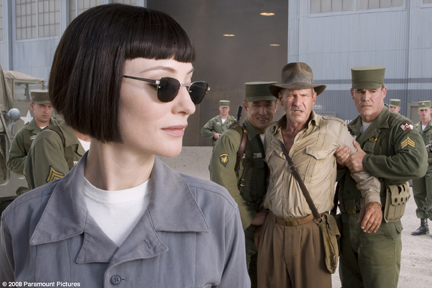 Shia LaBeouf is effective sidekick material. For the very busy young actor, this isn’t the kind of role that’s going to win him acting accolades, but like last year’s Transformers, it’s a further stepping stone toward stardom, and if nothing else LaBeouf, known so far as geeky boy-next-door types, shows that he can venture more into action hero territory without seeming ridiculous. Mutt compliments Indy well, mainly because he’s almost certainly the closest any sidekick has come to being an equal. He’s certainly a lot more appealing and a lot less irritating than Willie Scott or Short Round, and he can take care of himself in a scrape. It’s nice to see a familiar face other than Ford in the form of Karen Allen’s Marion (generally considered his worthiest love interest), but while Allen is throughout the second half of the film, and seems to be having fun returning to the series, she isn’t given much to do besides take the wheel during the lengthiest car chase, and resume her bickering with Indy for a short time before they get mushy like long-lost loves. It’s a bit disappointing that we don’t get any kind of smackdown between Marion and Spalko; in fact, the two women in the cast interact only fleetingly, and Marion doesn’t get to throw a punch. The supporting cast is talent-heavy with highly-regarded character actors- Cate Blanchett, Ray Winstone, John Hurt, Jim Broadbent- none of whom are given anything challenging. Cate Blanchett is underused, not given much to do besides stalking around looking stern, providing exposition about the Crystal Skull, threatening various characters with her rapier, and chasing Indy and company around the jungle, and is nowhere near Ronald Lacey’s Toht’s or Amrish Puri’s Mola Ram’s levels of nastiness. In fact, she’s disappointingly bland. Ray Winstone’s Mac is a plot device who switches allegiances whenever the script needs another twist. John Hurt is even more wasted, given nothing to do but wander around looking vacant and muttering unintelligibly. Even when he finally becomes lucid again, it’s too late for him to make an impression, and even then his utterances are less than profound; when Indy asks if the skulls’ owners have returned to outer space, Oxley replies ‘not space, but the space between spaces’. Huh? Part of what sometimes drags Crystal Skull down is the excess of supporting characters; what makes it worse is that they’re as flat as the pages they’re written on. Granted, we don’t come to Indiana Jones movies for deep character development, but previous supporting players, like Karen Allen’s Marion, Paul Freeman’s Belloq, Ronald Lacey’s Toht, and John Rhys-Davies’ Sallah all had a spark of something distinct about them that Spalko, Mac, and Oxley are missing.
Shia LaBeouf is effective sidekick material. For the very busy young actor, this isn’t the kind of role that’s going to win him acting accolades, but like last year’s Transformers, it’s a further stepping stone toward stardom, and if nothing else LaBeouf, known so far as geeky boy-next-door types, shows that he can venture more into action hero territory without seeming ridiculous. Mutt compliments Indy well, mainly because he’s almost certainly the closest any sidekick has come to being an equal. He’s certainly a lot more appealing and a lot less irritating than Willie Scott or Short Round, and he can take care of himself in a scrape. It’s nice to see a familiar face other than Ford in the form of Karen Allen’s Marion (generally considered his worthiest love interest), but while Allen is throughout the second half of the film, and seems to be having fun returning to the series, she isn’t given much to do besides take the wheel during the lengthiest car chase, and resume her bickering with Indy for a short time before they get mushy like long-lost loves. It’s a bit disappointing that we don’t get any kind of smackdown between Marion and Spalko; in fact, the two women in the cast interact only fleetingly, and Marion doesn’t get to throw a punch. The supporting cast is talent-heavy with highly-regarded character actors- Cate Blanchett, Ray Winstone, John Hurt, Jim Broadbent- none of whom are given anything challenging. Cate Blanchett is underused, not given much to do besides stalking around looking stern, providing exposition about the Crystal Skull, threatening various characters with her rapier, and chasing Indy and company around the jungle, and is nowhere near Ronald Lacey’s Toht’s or Amrish Puri’s Mola Ram’s levels of nastiness. In fact, she’s disappointingly bland. Ray Winstone’s Mac is a plot device who switches allegiances whenever the script needs another twist. John Hurt is even more wasted, given nothing to do but wander around looking vacant and muttering unintelligibly. Even when he finally becomes lucid again, it’s too late for him to make an impression, and even then his utterances are less than profound; when Indy asks if the skulls’ owners have returned to outer space, Oxley replies ‘not space, but the space between spaces’. Huh? Part of what sometimes drags Crystal Skull down is the excess of supporting characters; what makes it worse is that they’re as flat as the pages they’re written on. Granted, we don’t come to Indiana Jones movies for deep character development, but previous supporting players, like Karen Allen’s Marion, Paul Freeman’s Belloq, Ronald Lacey’s Toht, and John Rhys-Davies’ Sallah all had a spark of something distinct about them that Spalko, Mac, and Oxley are missing.
The only thing belying that Ford’s not as light on his feet as he used to be is the noticeably reduced number of major stunts he performs. That’s not to say he doesn’t do any, they’re just not the steady series he performed in previous outings. Ford’s best stunt work (if it’s all actually Ford, and it appears to be), is in the first third, especially during his warehouse escape, where he whips guns out of the bad guys’ hands, scrambles around over mountains of crates, swings from the rafters onto moving cars, and basically establishes that Indy is still Indy. It’s good that he gets this showcase, because after that Indy spends most of his time on the ground. There’s two car chases, and a fistfight, but not much swinging around (at least not by Indy). The next big action scene is a chase with Indy and Mutt on Mutt’s motorcycle tearing around and through Marshall College with Russkies in hot pursuit that ends up in the library. Maybe the movie’s most memorable action bit comes during this sequence, in which Indy is pulled off Mutt’s motorcycle and into the Russians’ car, and manages to fight his way out the other window and back onto the motorcycle. It combines nifty stunt work and clever action-comedy in the best tradition of Indiana Jones. Unfortunately, the movie is low on action for a while after that, and we spend time on Indy and Mutt trekking around Peru and too much talking about the Crystal Skull. The movie’s key action setpiece, a lengthy and somewhat disorganized car chase through the jungle , is hampered by too much CGI and too much silliness, including Mutt swinging through the trees like Tarzan. The earlier motorcycle chase has a nicely old-fashioned, no frills feel, and would have fit perfectly at home in any of the previous films, but the jungle chase does not. Despite some nifty stuntwork with Mutt and Spalko fencing on the tops of racing cars, this sequence still feels a pale shadow of the truck chase in Raiders, the tunnel race in Temple, or the tank duel in Last Crusade, and is indicative of the way the overall energy level is lower here.
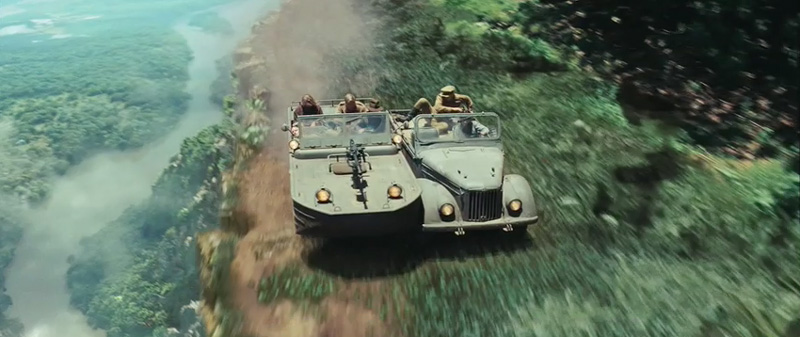 Spielberg and Lucas pull out all the stops to make this ‘feel’ like an Indiana Jones movie, relying in large part on the nostalgia many viewers will have for the original trilogy. There’s the old-fashioned Paramount mountain opening logo (one wonders if it’s a Lucas in-joke about lowering expectations when it turns into a prairie dog hill). We see pictures of Marcus Brody and Henry Jones Sr. Marshall College looks exactly the same. We revisit the same warehouse we saw at the end of Raiders, and the Ark of the Covenant makes a brief ‘cameo’. There’s the opening prologue action sequence featuring a tight spot and a daring Indy escape (although unlike the others, this one actually ties directly in with the main plot). There’s Indy’s fistfight with a hulking henchman, with Igor Jijikine filling in for the late Pat Roach. There’s also the obligatory creepy crawlies gross out moment, this time involving voracious red ants and borrowing a page from the man-eating beetles in The Mummy. The plot, while unnecessarily convoluted, very much follows the same blueprint as the others, particularly Raiders and Last Crusade: evil enemy military power seeks legendary object to tip scales in its favor, Indy and assorted sidekicks travel to remote regions racing against the baddies using clues in old legends and artifacts. There’s a ‘surprise revelation’ about a character that is unlikely to come as much of a shock for anyone who hasn’t been living under a rock for the past few months. The filmmakers also take advantage of the 1950s setting, starting right out with the opening, as Elvis Presley’s ‘You Ain’t Nothing But a Hound Dog’ blasts from radios, Howdy Doody is glimpsed on black-and-white television sets, Indy wanders onto atomic bomb test sites, his comeback when Spalko asks if he has any defiant last words is ‘I like Ike’ (this might go over some younger viewers’ heads, but some of the older audience members I attended with got a laugh out of it), and Mutt is introduced riding his Harley onto the screen dressed exactly like Marlon Brando in 1953’s The Wild One, down to the crooked cap. It has a lot of the familiar Indy ingredients, but there’s just not as much spark, and the energy and excitement level ebbs, with even the most exciting sequences not as exciting as what the series served up in the ’80s.
Spielberg and Lucas pull out all the stops to make this ‘feel’ like an Indiana Jones movie, relying in large part on the nostalgia many viewers will have for the original trilogy. There’s the old-fashioned Paramount mountain opening logo (one wonders if it’s a Lucas in-joke about lowering expectations when it turns into a prairie dog hill). We see pictures of Marcus Brody and Henry Jones Sr. Marshall College looks exactly the same. We revisit the same warehouse we saw at the end of Raiders, and the Ark of the Covenant makes a brief ‘cameo’. There’s the opening prologue action sequence featuring a tight spot and a daring Indy escape (although unlike the others, this one actually ties directly in with the main plot). There’s Indy’s fistfight with a hulking henchman, with Igor Jijikine filling in for the late Pat Roach. There’s also the obligatory creepy crawlies gross out moment, this time involving voracious red ants and borrowing a page from the man-eating beetles in The Mummy. The plot, while unnecessarily convoluted, very much follows the same blueprint as the others, particularly Raiders and Last Crusade: evil enemy military power seeks legendary object to tip scales in its favor, Indy and assorted sidekicks travel to remote regions racing against the baddies using clues in old legends and artifacts. There’s a ‘surprise revelation’ about a character that is unlikely to come as much of a shock for anyone who hasn’t been living under a rock for the past few months. The filmmakers also take advantage of the 1950s setting, starting right out with the opening, as Elvis Presley’s ‘You Ain’t Nothing But a Hound Dog’ blasts from radios, Howdy Doody is glimpsed on black-and-white television sets, Indy wanders onto atomic bomb test sites, his comeback when Spalko asks if he has any defiant last words is ‘I like Ike’ (this might go over some younger viewers’ heads, but some of the older audience members I attended with got a laugh out of it), and Mutt is introduced riding his Harley onto the screen dressed exactly like Marlon Brando in 1953’s The Wild One, down to the crooked cap. It has a lot of the familiar Indy ingredients, but there’s just not as much spark, and the energy and excitement level ebbs, with even the most exciting sequences not as exciting as what the series served up in the ’80s.
Another disappointing aspect is that the frantic second half never slows down enough for more than the most perfunctory ‘bonding’ between Indy and Mutt. There’s a missed opportunity to develop Indy and Mutt’s relationship into something like Indy’s relationship with his dad in The Last Crusade, another drawback of the excess of characters diluting the focus on the key relationship between Indy, Mutt, and Marion. Likewise, there’s still chemistry between Ford and Karen Allen, but their renewed relationship is given only the most perfunctory attention. One minute they’re bickering as though Raiders never ended, the next they’re getting mushy and giving each other adoring looks in between action sequences, which barely slow down long enough for them to catch a breath. This makes the epilogue in particular feel out of left field. It will undoubtedly provide satisfying closure for some Indy-Marion fans, but it doesn’t have enough leading up to it, and ends the movie on a somewhat ho-hum note. Spielberg and Lucas use CGI too liberally, throwing in some silly bits like reaction shots from animated prairie dogs (what, they couldn’t find any real prairie dogs?), and Mutt aping Tarzan (accompanied, as if the scene isn’t already goofy enough, by a small army of CGI monkies) at the lowest point of the jungle chase sequence. Indiana Jones movies have always been relatively tongue-in-cheek and not taken themselves terribly seriously, but these moments cross the line into too over-the-top attempts at comic relief.
Kingdom of the Crystal Skull isn’t unwatchable, but the freshness and energy of the original trilogy is sputtering at best. Harrison Ford still wears the fedora well, an underused Marion is better than no Marion, Shia LaBeouf is a welcome addition, and while the jungle chase gets a little carried away with CGI, . Nonetheless, the series is noticeably creaking with age here, and I think it’s time to Indy to hang up the whip.
**1/2
Disturbia (2007)
DIRECTOR: D. J. Caruso
CAST:
Shia LaBeouf, David Morse, Sarah Roemer, Carrie-Anne Moss, Aaron Yoo, Viola Davis, Matt Craven
REVIEW:
The sole crediting of Disturbia’s script to Carl Ellsworth (Red Eye) and Christopher Landon seems a little disingenuous, as the movie is as obviously an updated Rear Window as they come. While Ellsworth, Landon, and director D.J. Caruso (who would later reunite with Shia LaBeouf in Eagle Eye) don’t improve on the standard storyline, they at least keep it for the most part engaging and entertaining, and inject a measure of freshness into an oft-imitated basic plot.
We open with a father-son bonding moment between Kale Brecht (Shia LaBeouf) and his dad (Matt Craven) as they fly-fish in the picturesque great outdoors, that’s just a little too postcard-perfect/cutesy, like a scene off a Hallmark card, before Dad is brutally wiped off the screen in a startlingly abrupt car crash that goes from bad to worse. A year later, Kale is a juvenile delinquent who pays little attention to his grades, and commits a felony when he punches his Spanish teacher for bringing up his dad during a lecture on his bad behavior. As the last chance before going to jail, Kale is placed under house arrest and fitted with an ankle bracelet that alerts the police if he sets foot outside his yard. After a few days of video games which his Mom (Carrie-Anne Moss) blocks, swimsuit commercials (which Mom thwarts by severing the TV’s power cord), and junk food, visited only by his friend Ronny (Aaron Yoo), Kale starts spying on the neighbors out of boredom, especially new arrival Ashley (Sarah Roemer), who eventually catches him and joins in the neighborhood watch. For a while, things are harmless enough, until Kale starts to suspect his neighbor Mr. Turner (David Morse) of being a serial killer.
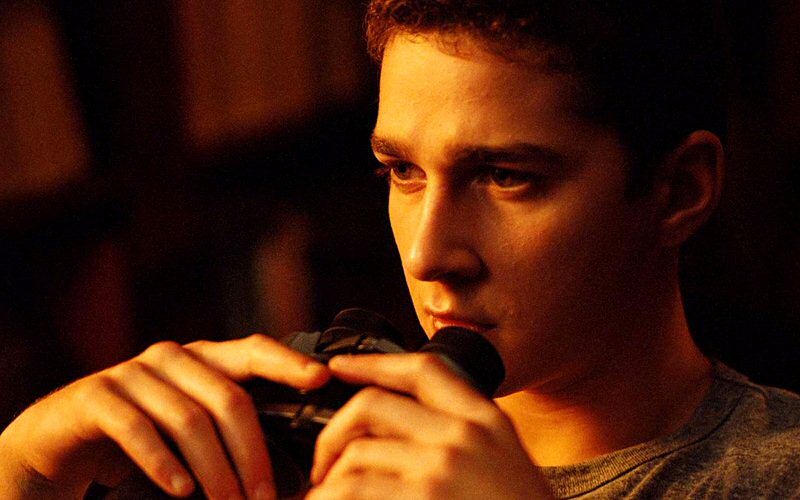 One thing that might surprise some viewers is the amount of time Disturbia takes to kick in with the thriller aspect. For a while, it seems to try to lull us into thinking it’s a teen romantic comedy, with only background television reports about a missing woman hinting at the danger to come. While Rear Window starts gradually, with Jimmy Stewart’s wheelchair-bound voyeur observing bickering couples and lonely spinsters, Kale and his accomplices watch the neighbor fooling around with the maid while the wife’s gone, and plot revenge against the brats who leave flaming poop on his doorstep. Fortunately, D.J. Caruso and Shia LaBeouf manage to keep all this entertaining- for the most part, so we’re not twiddling our thumbs waiting for LaBeouf to get menaced by David Morse. LaBeouf is not a spectacular actor, but he’s an appealing and energetic one, with the same kind of affable boy-next-door presence that made John Cusack so popular in ‘80s teen romantic comedies, and has a few more memorable moments scattered around, including an awkward, strangely sweet confession scene that could almost have come out of a John Hughes/John Cusack movie.
One thing that might surprise some viewers is the amount of time Disturbia takes to kick in with the thriller aspect. For a while, it seems to try to lull us into thinking it’s a teen romantic comedy, with only background television reports about a missing woman hinting at the danger to come. While Rear Window starts gradually, with Jimmy Stewart’s wheelchair-bound voyeur observing bickering couples and lonely spinsters, Kale and his accomplices watch the neighbor fooling around with the maid while the wife’s gone, and plot revenge against the brats who leave flaming poop on his doorstep. Fortunately, D.J. Caruso and Shia LaBeouf manage to keep all this entertaining- for the most part, so we’re not twiddling our thumbs waiting for LaBeouf to get menaced by David Morse. LaBeouf is not a spectacular actor, but he’s an appealing and energetic one, with the same kind of affable boy-next-door presence that made John Cusack so popular in ‘80s teen romantic comedies, and has a few more memorable moments scattered around, including an awkward, strangely sweet confession scene that could almost have come out of a John Hughes/John Cusack movie.
That Disturbia is designed as a Generation X version of Rear Window brings both pros and cons. Given that today’s teens (and younger) are embracing technology their parents find mind-boggling, it makes sense that Kale and company would use cell phones, digital cameras, and live video feed to spy on Mr. Turner. But packaging Disturbia to appeal to the young crowd also means it loses a little intelligence and depth. The level to which LaBeouf and the filmmakers portray Kale’s issues with his father’s death is inconsistent; he starts as a sullen delinquent, but for the rest of the movie he shows little of the edginess hinted at early on, and in fact the entire matter of his father’s death is pretty much forgotten about after a few perfunctory mentions. The movie toys half-heartedly with the possibility that Kale might, out of a combination of paranoia and boredom, be letting his imagination run away with him, but the possibility is never seriously explored, and Mr. Turner is shot as such a hulking, ominous presence that we never really buy that he might just be a shy, misunderstood regular guy.
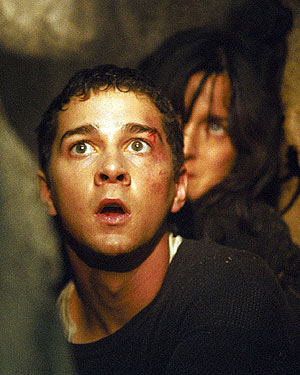 Shia LaBeouf has an affable presence, and makes Kale a likable everyman protagonist, which is important, especially since we spend significant set-up time following him on his daily (mis)adventures before we get into thriller territory. Sarah Roemer and Aaron Yoo provide adequate support. The movie takes time to give Kale and Ashley’s relationship a little more development than a perfunctory subplot. In teen-oriented movies like this, the adults seldom get much to do, and Disturbia isn’t an exception. David Morse lurks ominously in windows and shadowy garages and—when he’s finally seen up close and gets anything to say—drops vaguely threatening hints like “I like my privacy”. Carrie-Anne Moss gets the thankless role of the often-exasperated mother who drifts in and out of scenes as required by the plot, until the climax when she segues into the equally thankless role of a damsel in distress (for someone who was still kicking ass and looking great while doing it in The Matrix sequels a mere four years ago, it’s a little sad to see Moss already being relegated to throwaway “Mom” roles).
Shia LaBeouf has an affable presence, and makes Kale a likable everyman protagonist, which is important, especially since we spend significant set-up time following him on his daily (mis)adventures before we get into thriller territory. Sarah Roemer and Aaron Yoo provide adequate support. The movie takes time to give Kale and Ashley’s relationship a little more development than a perfunctory subplot. In teen-oriented movies like this, the adults seldom get much to do, and Disturbia isn’t an exception. David Morse lurks ominously in windows and shadowy garages and—when he’s finally seen up close and gets anything to say—drops vaguely threatening hints like “I like my privacy”. Carrie-Anne Moss gets the thankless role of the often-exasperated mother who drifts in and out of scenes as required by the plot, until the climax when she segues into the equally thankless role of a damsel in distress (for someone who was still kicking ass and looking great while doing it in The Matrix sequels a mere four years ago, it’s a little sad to see Moss already being relegated to throwaway “Mom” roles).
In the last half-hour or so, Disturbia pulls out the stops. There’s the mother trapped by serial killer, creaky doors, dark hallways and underground dungeon-like lairs, faces in windows, sinister figures revealed by lightning flashes, and a series of surefire “boo!” moments. Even those who think Disturbia takes too long to get into the thick of the action will mostly be satisfied by the finale.
Disturbia is not a classic thriller like the one it “borrows” from, but Shia LaBeouf is a likable and engaging protagonist, the movie never fails to be entertaining, and it wraps up with a few scenes guaranteed to get jolts out of the audience. In the thriller genre, there are a few better, but more that are much, much worse.
* * *
Holes (2003)
DIRECTOR: Andrew Davis
CAST:
Sigourney Weaver, Jon Voight, Patricia Arquette, Tim Blake Nelson, Shia LaBeouf, Khleo Thomas, Dulé Hill, Henry Winkler, Siobhan Fallon, Nathan Davis, Eartha Kitt, Scott Plank, Roma Maffia
REVIEW:
I wasn’t expecting too much from Holes the first time I saw it, and with some reason; Disney’s live-action films aren’t generally noted for their quality (or even for being bearable). Fortunately, Holes is a surprisingly enjoyable exception, well-acted, quirky, and with a surprising amount to offer adults as well as the young readers of Louis Sachar’s much-loved book. Continue reading
